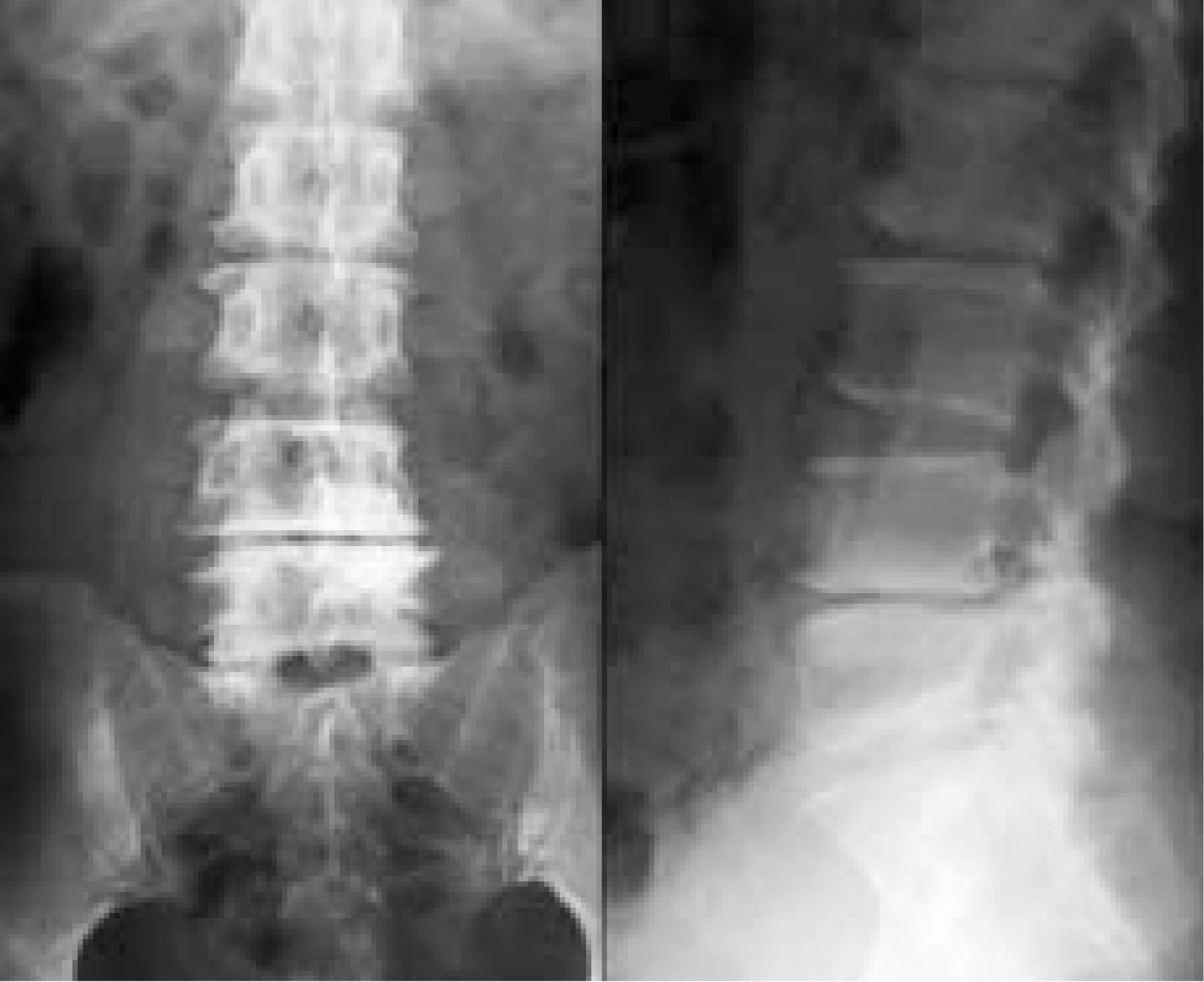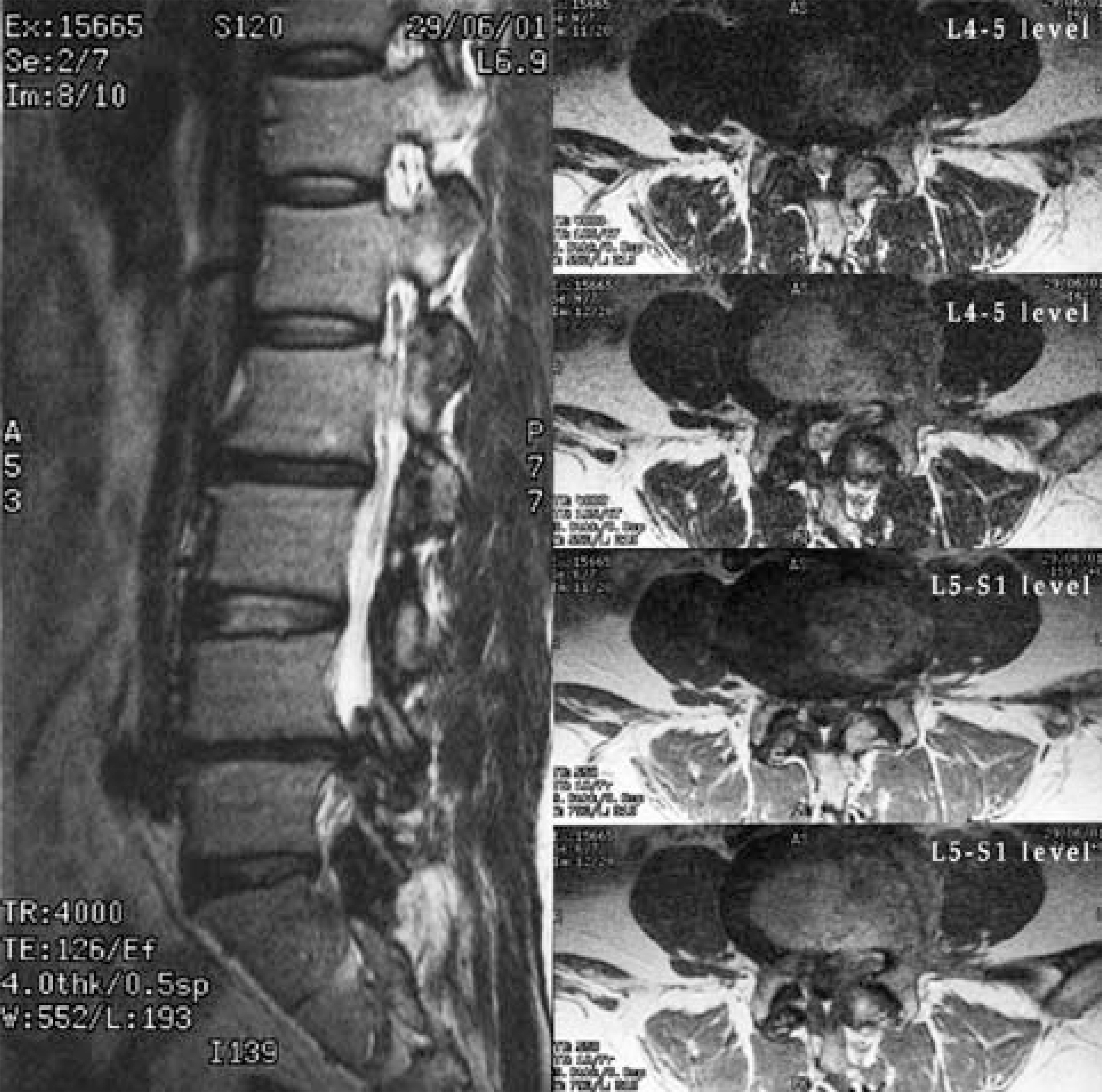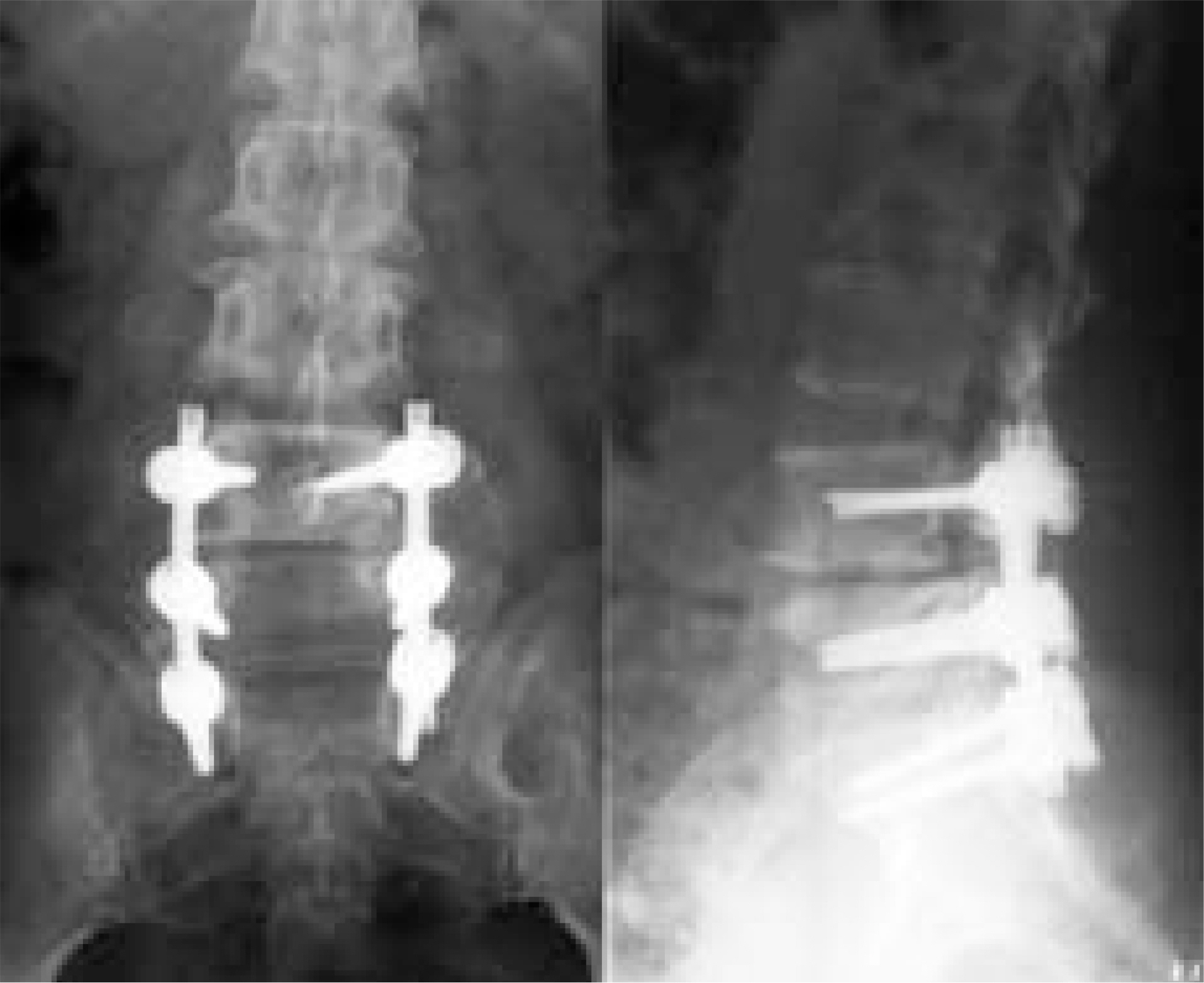J Korean Soc Spine Surg.
2007 Sep;14(3):144-150. 10.4184/jkss.2007.14.3.144.
Postlaminectomy Spinal Stenosis after Lumbar Discectomy
- Affiliations
-
- 1Department of Orthopedic Surgery, Inha University College of Medicine, Incheon, Korea. chokj@inha.ac.kr
- KMID: 1941645
- DOI: http://doi.org/10.4184/jkss.2007.14.3.144
Abstract
-
STUDY DESIGN: Retrospective study
OBJECTIVES
To investigate the type of postsurgical spinal stenosis in patients who had undergone a primary laminectomy and discectomy for a herniated lumbar disc, and to evaluate the clinical outcomes of the revision operation. SUMMARY AND LITERATURE REVIEW: Spinal stenosis occurs frequently after a laminectomy and discectomy. Facet joint arthritis, hypertrophy of the ligamentum flavum, iatrogenic instability, postsurgical scarring or any combination of these conditions can cause spinal stenosis.
MATERIALS AND METHODS
Twenty-four patients, who had postsurgical spinal stenosis were reviewed. Patients with a simple recurrent disc herniation without a spinal stenosis were excluded. The mean age was 52.5 years (range 31~70). There were 19 males and 5 females. The primary discectomy were performed at L4-5 in 21 patients, L5-1 in 2 patients, and both L4-5 and L5-1 in 1 patient. The mean interval between the first discectomy and revision surgery was 11.6 years (range 2.7~40). The anatomical site of the spinal stenosis, combined herniated disc, height of the disc space, segmental instability, hypertrophy of facet joint and thickening of the ligamentum flavum in radiographs was evaluated. The clinical outcome was measured using the Oswestry disability index.
RESULTS
Lateral spinal stenosis was observed in all patients. Eight patients showed both central and lateral stenosis. The lateral stenosis was caused by hypertrophy of the facet joint in 20 patients and a thickening of the ligamentum flavum in 8 patients. Nineteen patients showed herniated lumbar disc, including disc protrusion in 8 patients, disc extrusion in 9 patients, and disc sequestration in 2 patients. A loss of disc height was observed in 12 patients, segmental instability in 5 patients, and spondylolisthesis in 3 patients. All the patients received posterior decompression and posterolateral fusion with pedice screw instrumentation. Eighteen patients received a discectomy simultaneously. The average Oswestry score at the last visit was 24.4.
CONCLUSIONS
Postlaminectomy spinal stenosis resulted from a lateral spinal stenosis associated with facet joint hypertrophy. Recurrent disc herniation also contributed to the novel development of symptoms. A wide decompression and fusion provided good clinical outcomes.
MeSH Terms
Figure
Reference
-
1). Baba H, Chen Q, Kamitani K, Imura S, Tomita K. Revision surgery for lumbar disc herniation. Int Orthop. 1995; 19:98–102.
Article2). Homar CP, Peter D. Failed lumbar disc surgery. Clin Orthop Relat Res. 1982; 164:93–104.3). Fritsch EW, Heisel J, Rupp S. The failed back surgery syndrome. Spine. 1996; 21:626–633.
Article4). Adams MA, Hutton WC. Prolapsed intervertebral disc. A hyperflexion injury. Spine. 1982; 7:184–191.5). Campbell E, Whitfield RD. Certain reasons for failure following disc operations. NY State J Med. 1947; 47:2569–2572.6). Amundsen T, Weber H, Lilleas F, Nordal HJ, Abdel-noor M, Magnaes B. Lumbar spinal stenosis clinical and radiologic features. Spine. 1995; 20:1178–1186.7). Howard SA, Glover JM. Lumbar spinal stenosis: His-torical perspectives, classification and pathoanatomy. Seminars in spine surgery. 1994; 6-2:69–77.8). Lee HM, Kim NH, Kim HJ, chung IH. Morphometric study of the lumbar spinal canal in the Korean population. Spine. 1995; 20(15):1967–1984.
Article9). John KE, Rosen I, Uden A. The natural course of lumbar spinal stenosis. Clin Orthop Relat Res. 1992; 279:82–6.10). Scho¨nstro¨m N, Willen J. Imaging lumbar spinal stenosis. Radiol Clin North Am. 2001; 39:31–53.11). Cantu RC. Neurologic athletic head and neck injury. The cervical spinal controversy. Clin Sports Med. 1998; 17:121–126.12). Kim DY, Lee SH, Lee HY, et al. Validation of the Korean Version of the Oswestry Disability Index. Spine. 2005; 30:123–127.
Article13). Long DM, Filtzer DL, BenDebba M, Hendler NH. Clinical features of the failed-back syndrome. J Neurosurg. 1988; 69:61.
Article14). Suk SI, Lee JH, Min HJ, Kim HS, Ha CW, Park SE. Salvage procedure in failed low back surgery. J Korean Orthop Assoc. 1993; 28:1009–1016.
Article15). Kayaoglu CR, Calikoglu C, Binler S. Reoperation after lumbar disc surgery. J Int Med Res. 2003; 31:318–323.16). Bernard TN Jr. Repeat lumbar spine surgery. Spine. 1993; 18:2196–2200.
Article17). Ivanic GM, Pink TP, Homann NC, Scheitza W, Goyal S. The post-discectomy syndrome. Arch Orthop Trauma Surg. 2001; 121:494–500.
Article18). Steven R, Harry N, Mirkovic S. Spinal stenosis. J Bone Joint Surg. Am. 1999; 81-A:572–586.19). Breig A. Adverse mechanical tension in the central nervous system. An analysis of cause and effect. Stockholm: Almqvist & Wiksell International; New York: J. Wiley;1978.20). Turner JA, Ers M, Herron L, et al. Patient outcomes after lumbar spinal fusions, JAMA. 1992; 268:907–911.21). Katz JN, Lipson MSJ, Lew RA, et al. Lumbar laminectomy alone or with instrumented or noninstrumented arthrodesis in degenerative lumbar spinal stenosis patient selection, costs, and surgical outcomes, Spine. 1997; 22:1123–1131.
- Full Text Links
- Actions
-
Cited
- CITED
-
- Close
- Share
- Similar articles
-
- Complications and Management of Endoscopic Spinal Surgery
- A Case of Coexisting Cervical and Lumbar Spinal Stenosis
- Y-Angle Stenosis of Lumbar Spine: New Concept of Lumbar Stenosis
- Histopathological Analysis of Ligamentum Flavum in Lumbar Spinal Stenosis and Disc Herniation
- The Pathomorphologic Study of Spinal Stenosis as Seen on CT - Myelography of the Lumbar




